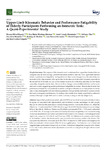Mostrar o rexistro simple do ítem
Upper-Limb Kinematic Behavior and Performance Fatigability of Elderly Participants Performing an Isometric Task: A Quasi-Experimental Study
| dc.contributor.author | López-López, Daniel | |
| dc.contributor.author | Silva-Migueis, Helena | |
| dc.contributor.author | Martínez-Jiménez, Eva María | |
| dc.contributor.author | Casado-Hernández, Israel | |
| dc.contributor.author | Dias, Adriano | |
| dc.contributor.author | Monteiro, Ana Júlia | |
| dc.contributor.author | Martíns, Rodrígo B. | |
| dc.contributor.author | Bernardes, Joao Marcos | |
| dc.contributor.author | Gómez Salgado, Juan | |
| dc.date.accessioned | 2023-05-22T05:38:56Z | |
| dc.date.available | 2023-05-22T05:38:56Z | |
| dc.date.issued | 2023-04 | |
| dc.identifier.citation | Silva-Migueis, H.; Martínez-Jiménez, E.M.; Casado-Hernández, I.; Dias, A.; Monteiro, A.J.; Martins, R.B.; Bernardes, J.M.; López-López, D.; Gómez-Salgado, J. Upper-Limb Kinematic Behavior and Performance Fatigability of Elderly Participants Performing an Isometric Task: A Quasi-Experimental Study. Bioengineering 2023, 10, 526. https://doi.org/10.3390/bioengineering10050526 | es_ES |
| dc.identifier.uri | http://hdl.handle.net/2183/33106 | |
| dc.description.abstract | [Abstract] Upper-limb position-sustained tasks (ULPSIT) are involved in several activities of daily living and are associated with high metabolic and ventilatory demand and fatigue. In older people, this can be critical to the performance of daily living activities, even in the absence of a disability. Objectives: To understand the ULPSIT effects on upper-limb (UL) kinetics and performance fatigability in the elderly. Methods: Thirty-one (31) elderly participants (72.61 ± 5.23 years) performed an ULPSIT. The UL average acceleration (AA) and performance fatigability were measured using an inertial measurement unit (IMU) and time-to-task failure (TTF). Results: The findings showed significant changes in AA in the X- and Z-axes (p < 0.05). AA differences in women started earlier in the baseline cutoff in the X-axis, and in men, started earlier between cutoffs in the Z-axis. TTF was positively related to AA in men until 60% TTF. Conclusions: ULPSIT produced changes in AA behavior, indicative of movement of the UL in the sagittal plane. AA behavior is sex related and suggests higher performance fatigability in women. Performance fatigability was positively related to AA only in men, where movement adjustments occurred in an early phase, though with increased activity time. | es_ES |
| dc.language.iso | eng | es_ES |
| dc.publisher | MDPI | es_ES |
| dc.relation.uri | https://doi.org/10.3390/bioengineering10050526 | es_ES |
| dc.rights | Atribución 3.0 España | es_ES |
| dc.rights.uri | http://creativecommons.org/licenses/by/3.0/es/ | * |
| dc.subject | Isometric activity | es_ES |
| dc.subject | Actividad isométrica | es_ES |
| dc.subject | Injuries | es_ES |
| dc.subject | Lesiones | es_ES |
| dc.subject | Musculoskeletal disease | es_ES |
| dc.subject | Enfermedades musculoesqueléticas | es_ES |
| dc.subject | Functional performance | es_ES |
| dc.subject | Rendimiento funcional | es_ES |
| dc.subject | Wearable technologies | es_ES |
| dc.subject | Tecnología con prendas de vestir | es_ES |
| dc.subject | Upper-ilmb movement | es_ES |
| dc.subject | Movimiento del miembro superior | es_ES |
| dc.title | Upper-Limb Kinematic Behavior and Performance Fatigability of Elderly Participants Performing an Isometric Task: A Quasi-Experimental Study | es_ES |
| dc.type | info:eu-repo/semantics/article | es_ES |
| dc.rights.access | info:eu-repo/semantics/openAccess | es_ES |
| UDC.journalTitle | Bioengineering | es_ES |
| UDC.volume | 10 | es_ES |
| UDC.issue | 5 | es_ES |
| UDC.endPage | 526 | es_ES |
Ficheiros no ítem
Este ítem aparece na(s) seguinte(s) colección(s)
-
GI-UDISAP - Artigos [193]






